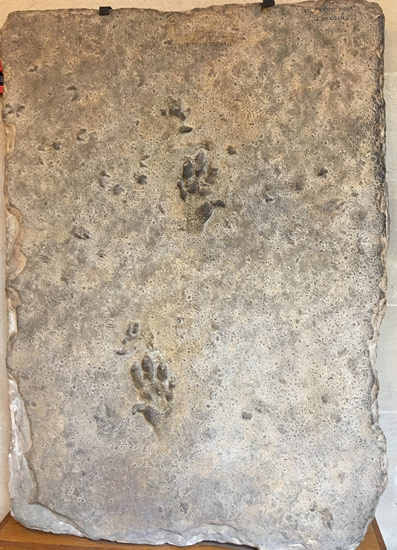Dinosaurs at Lymm (Cheshire)
Yesterday on ITV1 there was a programme called “Lost Treasures”, I think this is a programme produced by Northwest regional television, the idea being to showcase some of the more unusual things found in the countryside. Being based in the Granada region the programme focused on some of the mysterious objects and curiosities associated with villages in Cheshire.
I am not familiar with this TV programme, to be perfectly honest I don’t watch a lot of television, still it is nice to know when dinosaurs or prehistoric animals get a mention in the media. The host, Mark Olly and his team visited Lymm, a small village near Warrington in Cheshire and reported on the fossil trackways of a prehistoric animal that had been unearthed in the area. The outcrops of rock that can be seen in the Lymm area are red sandstone. These were laid down mainly in the Permian period (Permian period from 290-248 million years ago), although some sediment may be more recent (Triassic). During this time Cheshire (like much of Europe), was a vast sandy desert resembling the Sahara.
Dinosaurs at Lymm
An animal left a trackway in soft sandy sediment, much of Europe at the time was covered with a very salty sea (like the Dead sea), scientists have called this ancient waterway the Zechstein sea. The sea levels fluctuated frequently and an animal walked along a shoreline and the footprints are fossilised showing remarkable preservation. Unfortunately, the TV presenter stated that this fossil trackway was from an early dinosaur. This is simply not true, yet another case of television presenters believing that all animals that create fossils must be dinosaurs. Or is it more likely that if they talk about dinosaurs they are liable to keep the viewers interest?
An Ancient Trackway (Chirotherium Tracks)
Picture credit: Everything Dinosaur
Chirotherium or Cheirotherium?
The fossil trackway shows a four-footed animal with hind feet bigger than the front feet. The toes are clearly seen, in fact the prints so resembled an ape or human hand that the animal was named Cheirotherium (hand-beast). It is also sometimes known as Chirotherium. No fossils of this animal have ever been recovered but trackways of similar animals have been found in Germany and North America.
To see what the animal is supposed to have looked like search the Everything Dinosaur web log for images.
This animal was probably a diapsid (openings in the skull bones like dinosaurs) but an Archosaur (ruling reptiles), part of the group of reptiles from which dinosaurs are descended. From the claw marks that can still be clearly seen on the footprints, this animals was probably a carnivore – one of the biggest around at the time. It also possessed an upright stance unlike the sprawling stance of more primitive reptiles.
During the Triassic these types of archosaurs gradually became rarer as the dinosaurs began to establish themselves and out compete them. It would certainly have been interesting to travel back in time to see what gave the dinosaurs an evolutionary edge over the other archosaurs as by the end of the Triassic all these animals had become extinct.
Scientists are still debating just how closely related animals like Cheirotherium were to the actual dinosaurs. It did belong to the same group of reptiles – the archosaurs, but just how closely related it was to the ancestors of the dinosaurs is still hotly debated. Indeed, with relatively few fossils being preserved from this period, the ancestry of the dinosaurs and their development is still unclear.
Unfortunately, there are no models of Cheirotherium available (none that we can find anyway). Bullyland of Germany have specialised in producing models of European archosaurs from this period and have made a number of models, to view Everything Dinosaur’s range of dinosaur models and dinosaur toys for children, click the link below:
Dinosaur and prehistoric animal models available from Everything Dinosaur: Dinosaur and Prehistoric Animal Models.







Leave A Comment